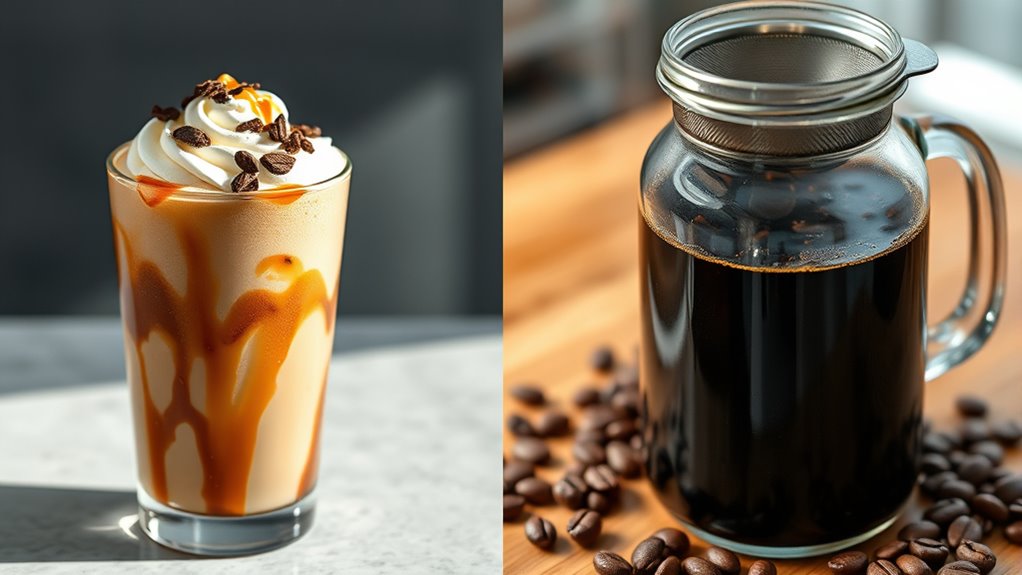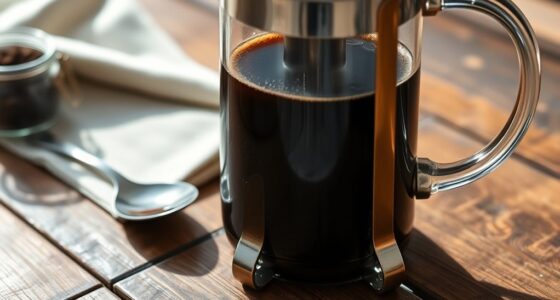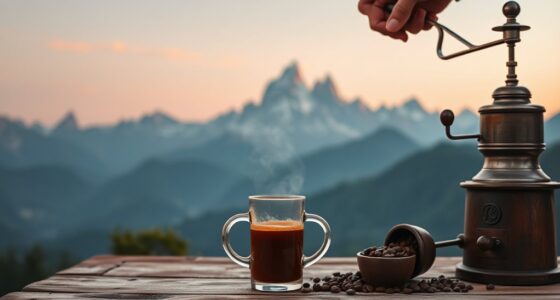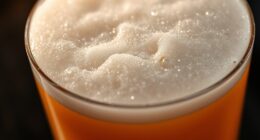If you’re choosing between iced coffee and cold brew, understanding their brewing methods makes all the difference. Iced coffee is made by brewing hot coffee first, then pouring it over ice, which extracts bold flavors quickly but can dilute as the ice melts. Cold brew steeped in cold water for 12-24 hours results in a smoother, less acidic drink with a different caffeine vibe. Continue exploring to discover how these differences affect your perfect cup.
Key Takeaways
- Iced coffee is hot brewed coffee cooled over ice, while cold brew is steeped in cold water over 12-24 hours.
- Hot brewing extracts flavors quickly, resulting in a vibrant taste; cold brew is a slow process producing a smoother profile.
- Iced coffee can be diluted when ice melts, whereas cold brew maintains flavor integrity over time.
- Cold brew generally has higher caffeine concentration and a softer, mellower flavor compared to hot brewed iced coffee.
- The brewing method directly influences flavor complexity, acidity, bitterness, and caffeine content.
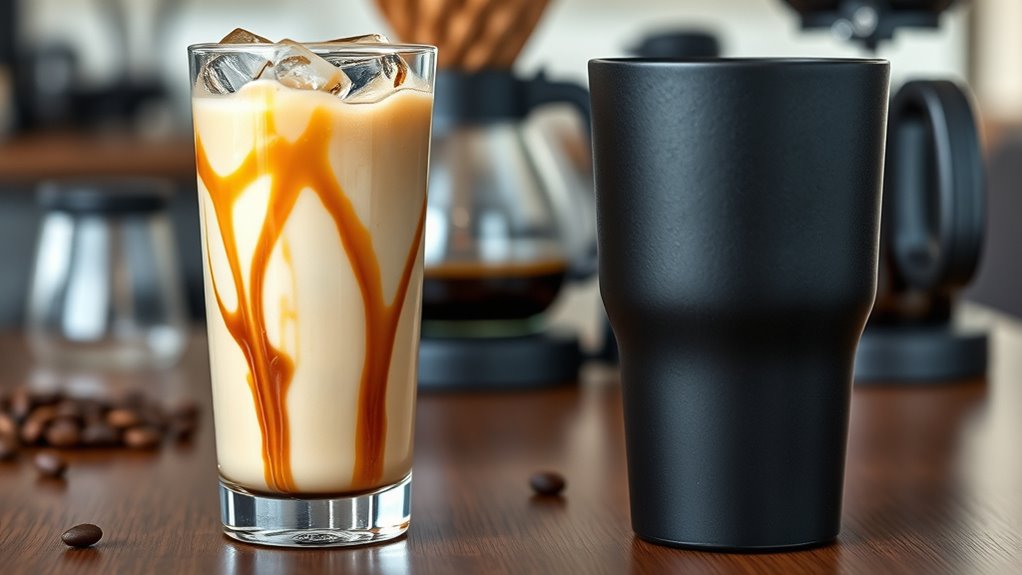
When it comes to invigorating summer beverages, iced coffee and cold brew are popular choices, but they differ markedly in preparation and flavor. If you’re trying to decide between the two, understanding their brewing methods can help. A key difference lies in brewing temperature, which directly influences not just flavor but also caffeine content.
With traditional iced coffee, you typically brew hot coffee first—using your usual brewing method like drip or pour-over—at a high temperature. This hot brew extracts flavors and caffeine quickly, resulting in a rich, aromatic coffee. Once brewed, you pour it over ice to cool it rapidly. Because of the hot brew, the caffeine content tends to be slightly higher per ounce compared to cold brew, and the flavor profile is often more vibrant and nuanced. The high brewing temperature helps extract a broad spectrum of compounds, including caffeine, resulting in a bold, lively taste that retains its brightness even after cooling. However, because the coffee is brewed hot, some of the flavors can become diluted as the ice melts, especially if you use a lot of ice or don’t serve it immediately.
Cold brew, on the other hand, involves a different approach. You steep coarsely ground coffee in cold or room temperature water for an extended period, usually 12 to 24 hours. The brewing temperature here is much lower—just ambient or refrigerated conditions—allowing the coffee to extract slowly over time. This slow extraction results in a smoother, mellower flavor profile, with fewer acidic or bitter notes, because the lower temperature prevents the formation of certain compounds. Caffeine extraction also occurs during this prolonged steeping, often leading to a higher overall caffeine content in the concentrate. This makes cold brew particularly potent, especially if you serve it straight or dilute it with water or milk. The slow brewing process also means that the caffeine is extracted more evenly, creating a consistent, robust caffeine punch that can last longer.
Frequently Asked Questions
Which Method Has a Higher Caffeine Content per Serving?
You might wonder which has more caffeine per serving, and it depends on factors like caffeine concentration and serving size. Cold brew generally has a higher caffeine concentration because it’s brewed with a higher coffee-to-water ratio and steeped longer. Since serving sizes can vary, a standard cold brew serving often contains more caffeine than iced coffee, making it a stronger pick if you’re seeking a caffeine boost.
Can I Make Cold Brew at Home Without Special Equipment?
In an era of home brewing innovation, you can definitely make cold brew without special equipment. Simply grind your coffee coarse, mix it with cold water, and let it steep for 12-24 hours in a jar or pitcher—no fancy gear needed. Strain the mixture through a fine mesh or cheesecloth, then enjoy your rich, smooth cold brew. It’s a simple process that transforms everyday ingredients into a delightful refreshment.
How Long Does Each Brewing Process Typically Take?
You’re curious about the brewing duration and preparation time for each process. Cold brew typically takes about 12 to 24 hours, requiring patience for a smooth, concentrated coffee. Iced coffee, on the other hand, has a shorter preparation time, usually around 5 to 10 minutes, since you brew hot coffee first and then chill it. Understanding these times helps you plan your coffee routine more efficiently.
Are There Health Benefits Associated With Cold Brew Over Iced Coffee?
You might think cold brew offers health benefits over iced coffee, and some studies suggest it has higher antioxidant levels due to its brewing process. Additionally, cold brew is often less acidic, which can be gentler on your stomach. Its smooth, less bitter taste encourages hydration, especially if you drink it without added sugar. So, if you’re looking for a potentially healthier, hydrating caffeine boost, cold brew could be the better choice.
What Are the Ideal Serving Temperatures for Each Beverage?
You should serve iced coffee around 40°F to maintain ideal flavor preservation without watering it down, while cold brew is best enjoyed at about 50°F to 60°F to highlight its smooth, rich taste. These serving temperatures help preserve the distinct flavors of each beverage. Keeping iced coffee colder ensures a invigorating experience, whereas slightly warmer cold brew allows you to savor its full depth and complexity.
Conclusion
Now that you know the distinct delights of iced coffee and cold brew, you can confidently choose your caffeine companion. Whether you crave the quick chill of iced coffee or the bold brew of cold brew, your perfect pick awaits. Embrace the exciting experience, savor the sensational flavors, and let each sip showcase your style. So, seize your favorite, settle in, and let these brewing beauties bring brightness to every brisk, beautiful day.
